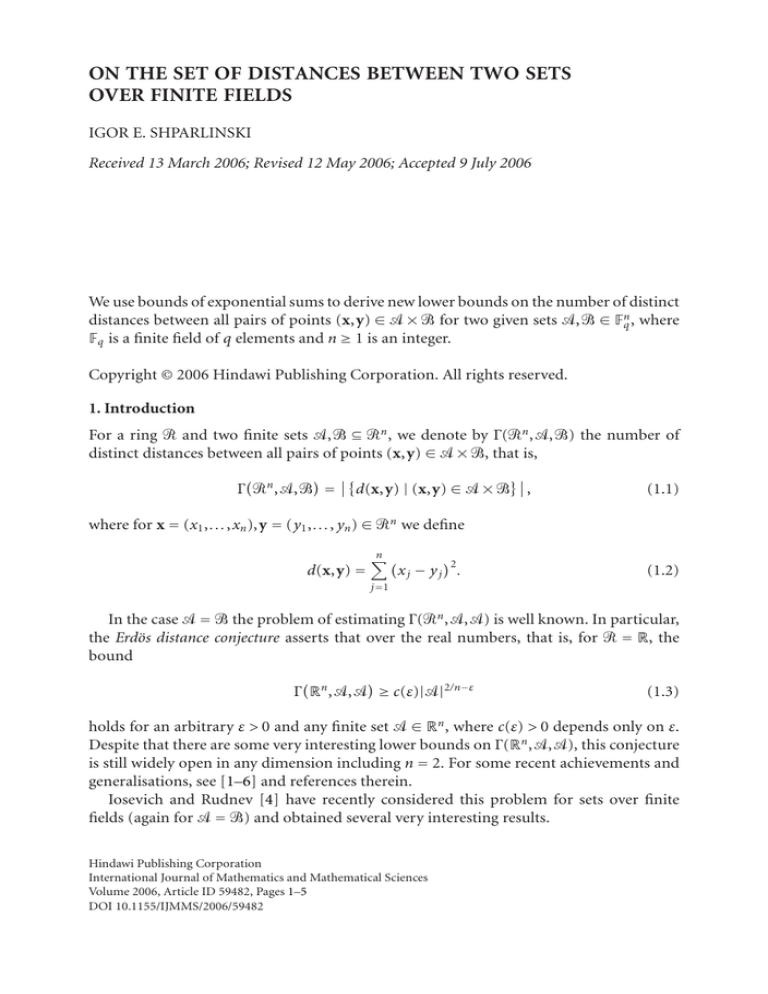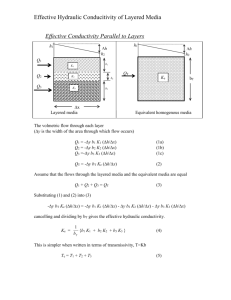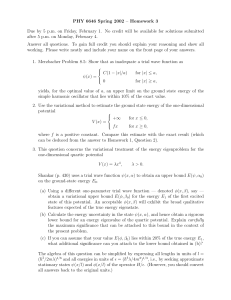
ON THE SET OF DISTANCES BETWEEN TWO SETS
OVER FINITE FIELDS
IGOR E. SHPARLINSKI
Received 13 March 2006; Revised 12 May 2006; Accepted 9 July 2006
We use bounds of exponential sums to derive new lower bounds on the number of distinct
distances between all pairs of points (x,y) ∈ Ꮽ × Ꮾ for two given sets Ꮽ,Ꮾ ∈ Fnq , where
Fq is a finite field of q elements and n ≥ 1 is an integer.
Copyright © 2006 Hindawi Publishing Corporation. All rights reserved.
1. Introduction
For a ring and two finite sets Ꮽ,Ꮾ ⊆ n , we denote by Γ(n ,Ꮽ,Ꮾ) the number of
distinct distances between all pairs of points (x,y) ∈ Ꮽ × Ꮾ, that is,
Γ n ,Ꮽ,Ꮾ = d(x,y) | (x,y) ∈ Ꮽ × Ꮾ ,
(1.1)
where for x = (x1 ,...,xn ),y = (y1 ,..., yn ) ∈ n we define
d(x,y) =
n
2
xj − yj .
(1.2)
j =1
In the case Ꮽ = Ꮾ the problem of estimating Γ(n ,Ꮽ,Ꮽ) is well known. In particular,
the Erdös distance conjecture asserts that over the real numbers, that is, for = R, the
bound
Γ Rn ,Ꮽ,Ꮽ ≥ c(ε)|Ꮽ|2/n−ε
(1.3)
holds for an arbitrary ε > 0 and any finite set Ꮽ ∈ Rn , where c(ε) > 0 depends only on ε.
Despite that there are some very interesting lower bounds on Γ(Rn ,Ꮽ,Ꮽ), this conjecture
is still widely open in any dimension including n = 2. For some recent achievements and
generalisations, see [1–6] and references therein.
Iosevich and Rudnev [4] have recently considered this problem for sets over finite
fields (again for Ꮽ = Ꮾ) and obtained several very interesting results.
Hindawi Publishing Corporation
International Journal of Mathematics and Mathematical Sciences
Volume 2006, Article ID 59482, Pages 1–5
DOI 10.1155/IJMMS/2006/59482
2
On the set of distances between two sets over finite fields
The case of arbitrary sets Ꮽ,Ꮾ ∈ Fnq has recently been studied in [8], where the lower
bound
qn+2
|Ꮽ||Ꮾ|
Γ Fnq ,Ꮽ,Ꮾ > q −
(1.4)
is given (which in some special case is new even for Ꮽ = Ꮾ). In particular, it is nontrivial
for |Ꮽ||Ꮾ| > qn+1 . The method of [8] rests on a new bound of exponential sums over the
set of distances. Here we use this bound in a slightly different way to derive an improvement of (1.4), which is nontrivial for |Ꮽ||Ꮾ| > qn .
In fact, one can easily adjust the method of [4] to the case of distinct sets Ꮽ and Ꮾ,
or in fact derive a lower bound on Γ(Fnq ,Ꮽ,Ꮾ) from already existing results of [4]. Such
bounds are usually stronger than the bound of this work. However in some extremal cases
our approach leads to a bound of the same order of magnitude which has completely
explicit (and perhaps better than those one can extract from [4]) constants. For example,
one can derive from [4] that if |Ꮽ||Ꮾ| > Cqn+1 , then Γ(Fnq ,Ꮽ,Ꮾ) = q, provided that C is
sufficiently large.
Furthermore, as in [8], given n polynomials f j (X,Y ) ∈ Fq [X,Y ], j = 1,...,n, we define
the generalised distance
df (x,y) =
n
fj xj, yj ,
(1.5)
j =1
where f = ( f1 ,..., fn ).
Now, for two sets Ꮽ,Ꮾ ⊆ Fnq , we define
Γf Fnq ,Ꮽ,Ꮾ = df (x,y) | x ∈ Ꮽ, y ∈ Ꮾ .
(1.6)
In the special case of the Euclidean distance function f0 = ( f1,0 ,..., fn,0 ), where f j,0 (X,Y ) =
(X − Y )2 , j = 1,...,n, we simply have
Γf0 Fnq ,Ꮽ,Ꮾ = Γ Fnq ,Ꮽ,Ꮾ .
(1.7)
In particular, under some conditions on f, the bound
Γf Fnq ,Ꮽ,Ꮾ = q + O
q3n/2+2
|Ꮽ||Ꮾ|
(1.8)
has been given in [8]. Here we show that the power of q in the error term can be lowered
to q3n/2+1 .
2. Euclidean distances
We start with the case of Euclidean distances and improve the bound (1.4).
Theorem 2.1. For arbitrary sets Ꮽ,Ꮾ ⊆ Fnq ,
Γ Fnq ,Ꮽ,Ꮾ >
|Ꮽ||Ꮾ|q
qn+1 + |Ꮽ||Ꮾ|
.
(2.1)
Igor E. Shparlinski 3
Proof. Let χ be a nontrivial additive character of Fq (see [7] for basis properties of additive
characters). In particular, we recall the identity
s∈Fq
⎧
⎨0
χ(st) = ⎩
q
if t ∈ F∗q ,
if t = 0.
(2.2)
As in [8], we consider character sums
S(a,Ꮽ,Ꮾ) =
χ ad(x,y) ,
a ∈ Fq ,
(2.3)
x ∈Ꮽ y ∈Ꮾ
where as before d(x,y) is given by (1.2).
Our principal tool is the upper bound
S(a,Ꮽ,Ꮾ) ≤ |Ꮽ||Ꮾ|qn ,
(2.4)
which is established in [8] for any a ∈ F∗q .
For λ ∈ Fq , we denote by N(λ) the number of representations λ = d(x,y) with (x,y) ∈
Ꮽ × Ꮾ.
Then by (2.2) we have
N(λ) =
1 1 1 χ a d(x,y) − λ =
χ(−aλ)S(a,Ꮽ,Ꮾ).
q x∈Ꮽ y∈Ꮾ q a∈Fq
q a∈Fq
(2.5)
Hence,
N(λ)2 =
λ∈Fq
1 χ (b − a)λ S(a,Ꮽ,Ꮾ)S(b,Ꮽ,Ꮾ)
2
q λ∈F a,b∈F
q
=
q
1
S(a,Ꮽ,Ꮾ)S(b,Ꮽ,Ꮾ)
χ (b − a)λ
q2 a,b∈F
λ∈F
q
=
(2.6)
q
1 S(a,Ꮽ,Ꮾ)2 ,
q a∈Fq
since by (2.2) the sum over λ vanishes unless a = b.
We now use the bound (2.4) for a ∈ F∗q and the trivial bound |S(a,Ꮽ,Ꮾ)| ≤ |Ꮽ||Ꮾ|
for a = 0, getting
N(λ)2 < |Ꮽ||Ꮾ|qn + |Ꮽ|2 |Ꮾ|2 q−1 .
(2.7)
λ∈Fq
Clearly
λ∈Fq
N(λ) = |Ꮽ||Ꮾ|.
(2.8)
4
On the set of distances between two sets over finite fields
Now by the Cauchy inequality we derive
2
|Ꮽ||Ꮾ| =
2
N(λ)
≤ Γ Fnq ,Ꮽ,Ꮾ
N(λ)2
λ∈Fq
λ∈Fq
(2.9)
< Γ Fnq ,Ꮽ,Ꮾ |Ꮽ||Ꮾ|qn + |Ꮽ|2 |Ꮾ|2 , q−1 ,
which implies the desired result.
3. Generalised distances
We now use similar arguments to improve the bound (1.8).
Theorem 3.1. Let f = ( f1 ,..., fn ), where each of the polynomials f j (X,Y ) ∈ Fq [X,Y ], j =
1,...,n, is of degree at most k and is not of the form f j (X,Y ) = g j (X) + h j (Y ) with g j (X) ∈
Fq [X], h j (Y ) ∈ Fq [Y ]. Then, for arbitrary sets Ꮽ,Ꮾ ⊆ Fnq ,
Γf Fnq ,Ꮽ,Ꮾ = q + O
q3n/2+1
.
|Ꮽ||Ꮾ|
(3.1)
Proof. Here, instead of the bound (2.4), we use the bound
Sf (a,Ꮽ,Ꮾ) = O |Ꮽ||Ꮾ|q3n/2 ,
a ∈ F∗q ,
(3.2)
a ∈ Fq ,
(3.3)
which is established in [8] for the character sums
Sf (a,Ꮽ,Ꮾ) =
χ adf (x,y) ,
x ∈Ꮽ y ∈Ꮾ
where df (x,y) is given by (1.5).
Let Nf (λ) be the number of solutions to the equation
df (x,y) = λ,
x ∈ Ꮽ, y ∈ Ꮾ.
(3.4)
As in the proof of Theorem 2.1, using (3.2) instead of (2.4), we deduce
Nf (λ)2 =
λ∈Fq
1 S(a,Ꮽ,Ꮾ)2 = |Ꮽ|2 |Ꮾ|2 q−1 + O |Ꮽ||Ꮾ|q3n/2 .
q a∈Fq
(3.5)
As before, we also have
λ∈Fq
Nf (λ) = |Ꮽ||Ꮾ|,
(3.6)
Igor E. Shparlinski 5
and by the Cauchy inequality we derive
2
|Ꮽ||Ꮾ| =
λ∈Fq
2
N(λ)
≤ Γ Fnq ,Ꮽ,Ꮾ
N(λ)2
λ∈Fq
(3.7)
< Γ Fnq ,Ꮽ,Ꮾ |Ꮽ|2 |Ꮾ|2 q−1 + O |Ꮽ||Ꮾ|q3n/2 ,
which implies the desired result.
Acknowledgments
The author is very grateful to Alex Iosevich for many useful discussions and encouragement, in particular, for clarifying how the results and methods of [4] can be modified
to incorporate the case of distinct sets Ꮽ = Ꮾ. During the preparation of this note, the
author was supported in part by ARC Grant DP0556431.
References
[1] M. B. Erdogan, A bilinear Fourier extension theorem and applications to the distance set problem,
International Mathematics Research Notices 2005 (2005), no. 23, 1411–1425.
[2] S. Hofmann and A. Iosevich, Circular averages and Falconer/Erdös distance conjecture in the plane
for random metrics, Proceedings of the American Mathematical Society 133 (2005), no. 1, 133–
143.
[3] A. Iosevich and I. Łaba, Distance sets of well-distributed planar point sets, Discrete & Computational Geometry 31 (2004), no. 2, 243–250.
[4] A. Iosevich and M. Rudnev, Erdös distance problem in vector spaces over finite fields, to appear in
Transactions of the American Mathematical Society.
, Spherical averages, distance sets, and lattice points on convex surfaces, preprint, 2005.
[5]
[6] N. H. Katz and G. Tardos, A new entropy inequality for the Erdös distance problem, Towards a
Theory of Geometric Graphs, Contemp. Math., vol. 342, American Mathematical Society, Rhode
Island, 2004, pp. 119–126.
[7] R. Lidl and H. Niederreiter, Finite Fields, Encyclopedia of Mathematics and Its Applications, vol.
20, Cambridge University Press, Cambridge, 1997.
[8] I. E. Shparlinski, On some generalisations of the Erdös distance problem over finite fields, Bulletin
of the Australian Mathematical Society 73 (2006), no. 2, 285–292.
Igor E. Shparlinski: Department of Computing, Macquarie University, Sydney, NSW 2109, Australia
E-mail address: igor@ics.mq.edu.au








